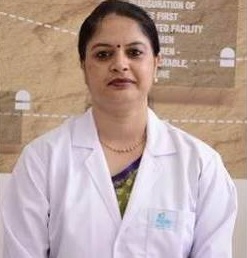Ovarian Cancer Surgery - Procedure, Survival Rate & Recovery

Treatment Duration
1 Hours
------ To ------2 Hours
Treatment Cost
₹ 50,000
------ To ------₹ 1,50,000

Ovarian cancer is when cells in the ovaries become abnormal. The cells divide quickly and can attack and kill healthy body tissue.
|
Surgery Name |
Ovarian Cancer Surgery |
|
Alternative Name |
Extra-ovarian primary peritoneal carcinoma |
|
Disease Treated |
Ovarian Cancer |
| Benefits of the Surgery | Cures Cancer, Increased Survival Rate, Minimally Invasive, High Success Rate |
| Treated By | Gynaecologic Oncologist |
You can check Ovarian Cancer Surgery Cost here.
Anatomy and Physiology of the Ovaries
- On each side of the womb, there are two ovaries, located within the pelvis.
- The ovaries are around the size and shape of a huge olive.
- The ovaries help in producing eggs as well as female hormones.
- Estrogen and progesterone are the principal female hormones generated by the ovaries. These hormones control the menstrual cycle, pregnancy, and the physical development of a woman's breasts, and hair.
Ovarian Cancer Surgery Videos by HexaHealth
Expert Doctors (10)
NABH Accredited Hospitals (10)


How is Ovarian Cancer Surgery performed?
The majority of Ovarian Cancers are treated with surgery. It can be done in one of two ways:
- A laparotomy surgery opens up the abdomen with an incision.
- A laparoscopy uses small incisions.
Types of Surgery
The primary goals of epithelial ovarian cancer surgery include staging and debulking. Staging is performed to identify the spread of cancer from the ovary. Debulking is necessary when ovarian cancer spreads over the belly during the surgery.
The types of Staging Surgeries for ovarian cancer are:
- Omentectomy- The omentum, a fold of fatty tissue inside the belly, is surgically removed. During this procedure, some lymph nodes in the pelvis and abdominal area will also be biopsied.
- Unilateral salpingo- Oophorectomy- Single ovary and single fallopian tube were removed by surgery.
- Bilateral salpingo- Oophorectomy- Both ovaries and fallopian tubes are surgically removed.
- Total hysterectomy- The uterus, along with the cervix, is removed by the surgeon.
- Sometimes, to debulk, the cancer surgeon may need to remove a part of the colon, small intestine, bladder, spleen, stomach, liver, pancreas or gallbladder. Various types of surgeries are performed to remove the parts mentioned above. It includes Bowel resection, colostomy, ileostomy etc.
- Germ cell tumour and ovarian stromal tumour surgeries
- Hysterectomy and bilateral salpingo-oophorectomy are the most common treatments for ovarian germ cell tumours. If you have cancer in only one ovary and yet wish to have children, you will have the cancerous ovary and the fallopian tube on the same side removed. This way, the other ovary, fallopian tube, and uterus will help you get pregnant.
- Because ovarian stromal tumours usually affect just one ovary, surgery is required only to remove that ovary.
- Debulking surgery for Epithelial Ovarian Cancer: Removal of the tumour is known as debulking. It is essential when cancer has spread all over the belly. The objective of the debulking is to leave behind no cancer or no tumours larger than 1 cm.
- Intraoperative Imaging- The surgeon will utilise imaging tests before the surgery to determine the location of the cancer and sometimes uses bright light to feel.
- The tumours during the operation as well to determine where the ovarian cancer is located and how it should be removed. In addition, a fluorescent drug is also injected into the body before the surgery, which attaches to a protein found in cancerous ovarian cells, which aids in locating the tumours.
What to expect Before and During the Surgery?
Before the Surgery
The patient is advised to get a pre-anaesthetic checkup before the surgery. Doctors may perform specific tests a week or two before surgery to ensure you are healthy enough for the procedure. The tests include the following:
- Complete blood picture and urine test.
- X-ray shows your heart and lungs
- Check your baseline cardiac rhythm with an electrocardiogram (EKG or ECG).
- Before the operation, ask your doctor if you need to stop taking any medications, vitamins, or herbal products+.
- The night before your procedure, the doctor will advise you not to eat or drink anything after midnight.
On the day of the Surgery
- The patient is informed regarding the procedure, and consent is made to sign by the patient.
- Patient is requested to change into a gown before entering the surgical room.
- If a patient is carrying jewellery, glasses or contact lenses, hearing aids, or a wig, the nurse will remind them to remove it.
- Patients' heart rate, temperature, blood pressure, and pulse are all checked by a nurse.
During the Surgery
- The Surgeon makes a mark on your body to represent where the procedure will be performed.
- An IV line is inserted by the nurse into your arm so that the surgeon can administer medications and fluids throughout the procedure.
- The vitals of the patient are monitored throughout the surgery.
What to expect After the Surgery?
Recovery Process in the Hospital
- Until the patient gains consciousness after the surgery, they will be kept in the recovery room.
- The recovery period generally depends on the type of surgery; it ranges from three to seven days in the hospital and four to six weeks at home.
Recovery after the Surgery
- Doctors may prescribe painkillers to reduce any discomfort or pain at the surgical site.
- If the patient feels nauseated, antiemetic medications are prescribed.
- Menopause symptoms such as vaginal dryness and hot flushes are frequent. Along with vaginal bleeding, which may last for two weeks.
- Physical therapists may recommend breathing and leg exercises to help heal and prevent blood clots.
- A healthcare practitioner may inject blood thinners to lower the danger of blood clots.
- Those who have a section of their colon removed may need to wear a colostomy bag for a while.
- A temporary catheter may also be required to empty urine when a portion of the bladder has been removed.
- Rest as much as possible, consume a healthy diet, exercise, and avoid driving and lifting heavyweights. Patients may need to stop working after surgery until they have recovered.
- Swimming and bathing should be avoided during the healing period. To allow the body to heal, people should refrain from having sex for at least six weeks after the operation.
First follow up Appointment
- After finishing the first treatment, every three to four months for the starting two to three years.
- Every four to six months for the next three years, then once a year.
- Physical examination which includes examining the pelvis, rectum, lymph nodes, groin and legs.
Benefits of Surgery for Ovarian Cancer
- It is beneficial in patients with early and advanced stages of cancer.
- It is also beneficial in patients whose cancer has recurred even after the treatment.
- The survival rate also increases with surgery.
- Some early-stage ovarian cancer patients may benefit from less invasive ovarian tumour removal.
- You have a previous history of breast, colorectal or endometrial cancer diagnosis.
- You have a syndrome linked with a high risk of ovarian cancer, such as Peutz-Jeghers syndrome or Lynch Syndromme.
When is Doctor's Consultation needed?
Consult a doctor immediately if any of the following complications are noticed:
- It includes infection, fever, redness or inflammation at the site of surgery,
- Vaginal bleeding, irregular or heavy, Green or yellow discharge, rare internal bleeding, and irregularity in the passing of bowels and blood clots.
Risks of Delayed Ovarian Cancer Surgery
- If the surgery is delayed it may result in the spread of cancer to other organs.
- Mortality rate increases.
- After the detection of cancer, a delay in surgery every four weeks results in a 6-8 % increase in the risk of death.
- Further delay in surgery between 8-12 weeks results in a 17-26% increase in the risk of death.
More Treatment options
Last Updated on: 26 November 2022
Author
HexaHealth Care Team
HexaHealth Care Team brings you medical content covering many important conditions, procedures falling under different medical specialities. The content published is thoroughly reviewed by our panel of qualified doctors for its accuracy and relevance.
Latest Health Articles
Other Treatments in Your City






























